As Borussia Dortmund start preparations for the new season, a familiar face will be back in the dugout. Following the departure of Marco Rose, the Bundesliga club have appointed from within and Edin Terzic will once again take the reins at the Signal Iduna Park.
Terzic has penned a three-year contract until 2025 and will leave his role as Technical Director, which he filled for one season after finishing his first stint in charge of Dortmund as interim manager. The 39-year-olf is a popular choice amongst the fans as he is seen as an appointment who has a connection to the club.
He was raised in a town just outside Dortmund, called Menden and was first on BVB’s books as a scout in 2010. After this, he went on to be assistant coach of the U17, U19 and reserve sides before accepting roles as assistant first-team coach at Besiktas and West Ham United under Slaven Bilic, later returning to the club as assistant to Lucian Favre in 2018.
This article provides a tactical analysis of how Borussia Dortmund will look to play under Edin Terzic. We will analyse the tactics and the key principles of his philosophy to show what Dortmund can expect as he looks to implement his ideas as their full-time manager.
Defensive Phase
When Terzic took over from Lucian Favre in December 2020, he initially set Dortmund up in a 4-2-3-1 formation and looked to defend in a 4-4-2 shape.
Just before his dismissal, Favre had moved away from his preferred 4-2-3-1 formation and opted to play a 3-4-2-1 due to Dortmund’s vulnerabilities in the centre-back position.
Defensively, the same troubles remained, and Dortmund was often exposed between the lines during the opposition’s build-up and the space behind the fullbacks during attacking transition. Leipzig have three players positioned between Dortmund’s defensive lines and right across their defensive third.
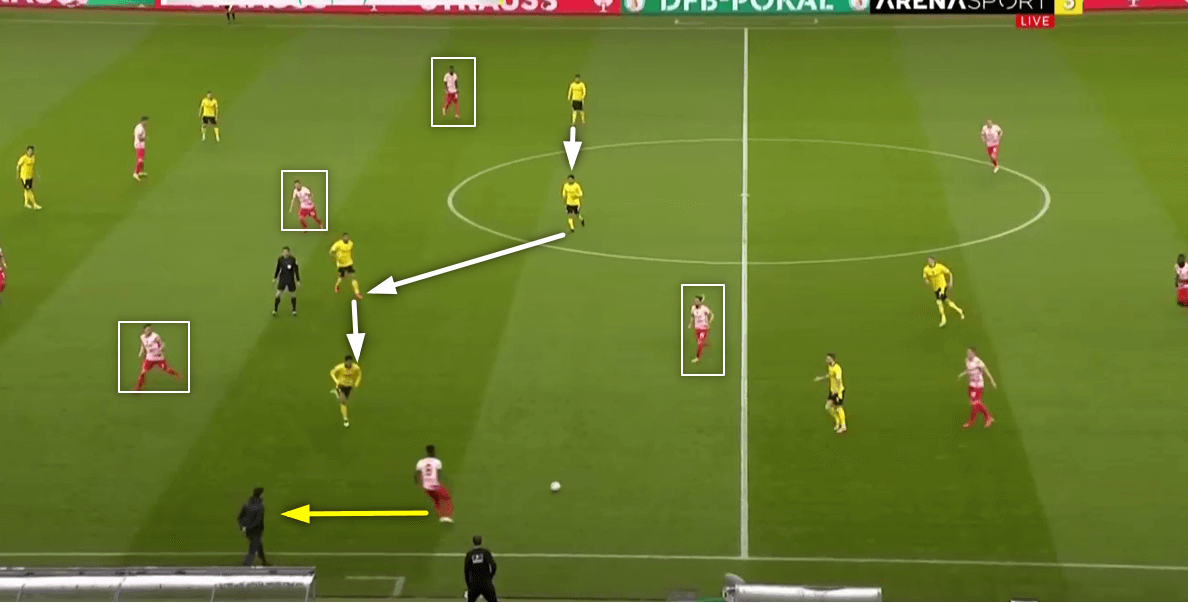
Following this, Terzic changed Dortmund’s defensive shape. Although the 4-2-3-1 approach was sometimes still used, a 4-3-3 was primarily adopted so Dortmund defended in a 4-1-4-1 shape.
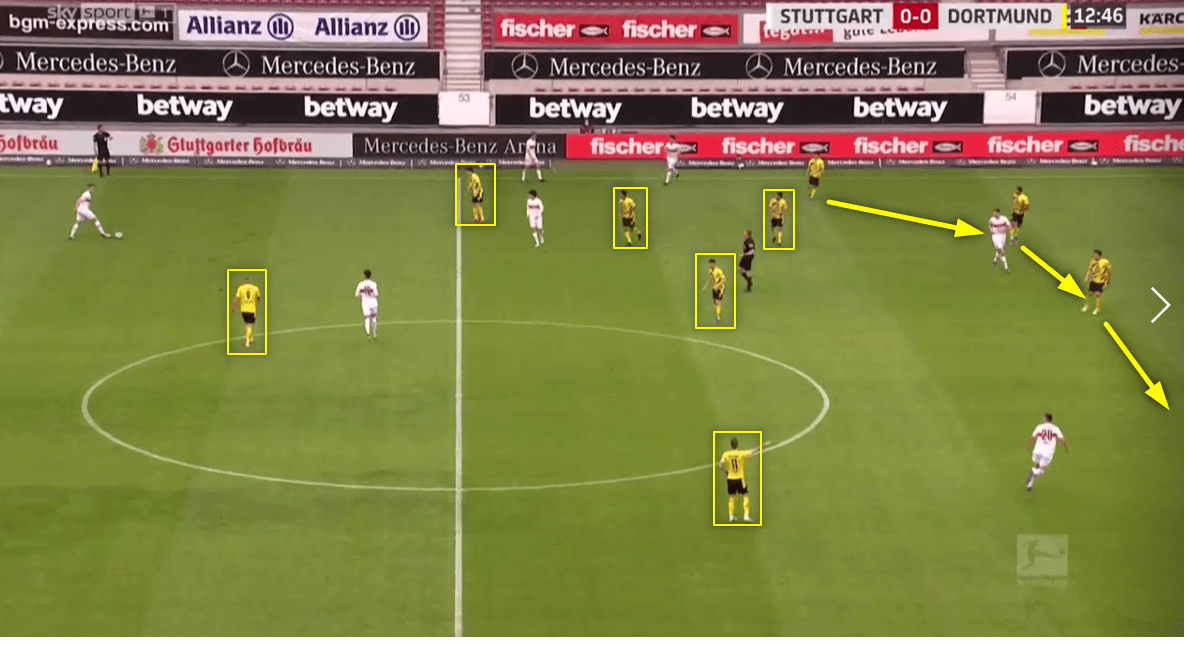
The 4-4-2 against the ball was still deployed when the opposition’s defence played the ball across their defensive line but only positionally as Dortmund’s pressing structure became a position-oriented zonal press, meaning each man in their defensive shape pressed the man in possession as the play entered their zone.
The image below shows Dortmund’s 4-1-4-1 shape but as RB Leipzig builds through their centre-backs, Marco Reus leaves his position in the bank of four to join Erling Haaland to make a front two which creates a 4-4-2 shape. Once the play goes back across to the other side Reus would drop back into position and Jadon Sancho would perform a similar action, as would one of the central midfielders if the opposition attempts to play vertically through the centre of the pitch.
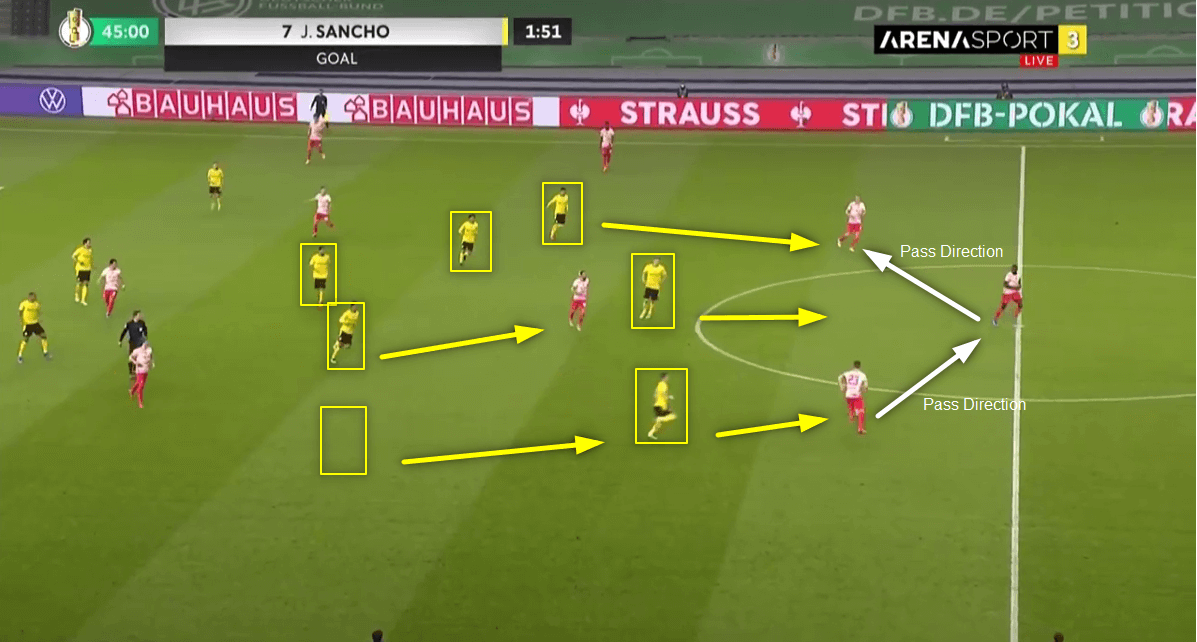
The introduction of the holding midfielder gave the defence extra protection and allowed Dortmund to keep two banks of four within their defensive shape, as the holding midfielder joins the midfield line to cover the space vacated by the player who pushes forward to press.
This is one of the benefits of the 4-1-4-1 shape compared to the 4-4-2 shape. The 4-4-2 defensive approach can make a team one-dimensional in their attempts to regain possession and if one player gets pulled from his position in a 4-4-2 shape it can break your defensive structure. Whereas a 4-1-4-1 defensive shape can give more flexibility as they switch to a 4-4-2, 4-2-3-1 or a 4-3-3, and can different pressing triggers between each to catch the opposition out.
The same defensive shape is applied when they implement a high block. Which is an approach Edin Terzic wants Dortmund to play. He wants his team to play high up the pitch and try and stop the opposition from building from their defence and through each third of the pitch.
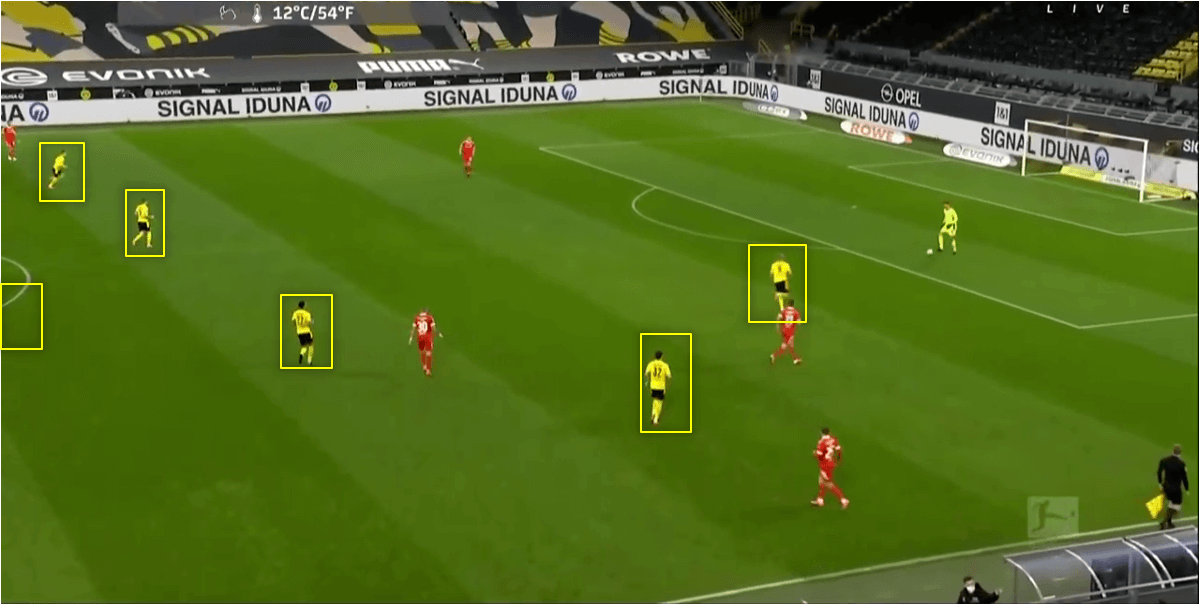
The same positional pressing system is applied, however, as you can see in the image below, they have applied a man-to-man marking system to cut off the closet passing option for the ball carrier.
Although Dortmund will be compact out of possession under Terzic, their aim isn’t to protect the pitch centrally and force the opposition out wide. They want to be narrow and compact as they want to be able to apply a counter-pressing approach once they have forced the opposition into specific scenarios when they hold possession.
The image below shows a high 4-1-4-1 defensive block. As Sancho presses the man holding possession. Haaland is starting his run towards the centre back about to receive the ball. However, the pressing strategy instructed by Terzic means Haaland won’t aggressively press the centre back. He will arch his run and cut off the passing lane and stop Monchengladbach from opening up the pitch.
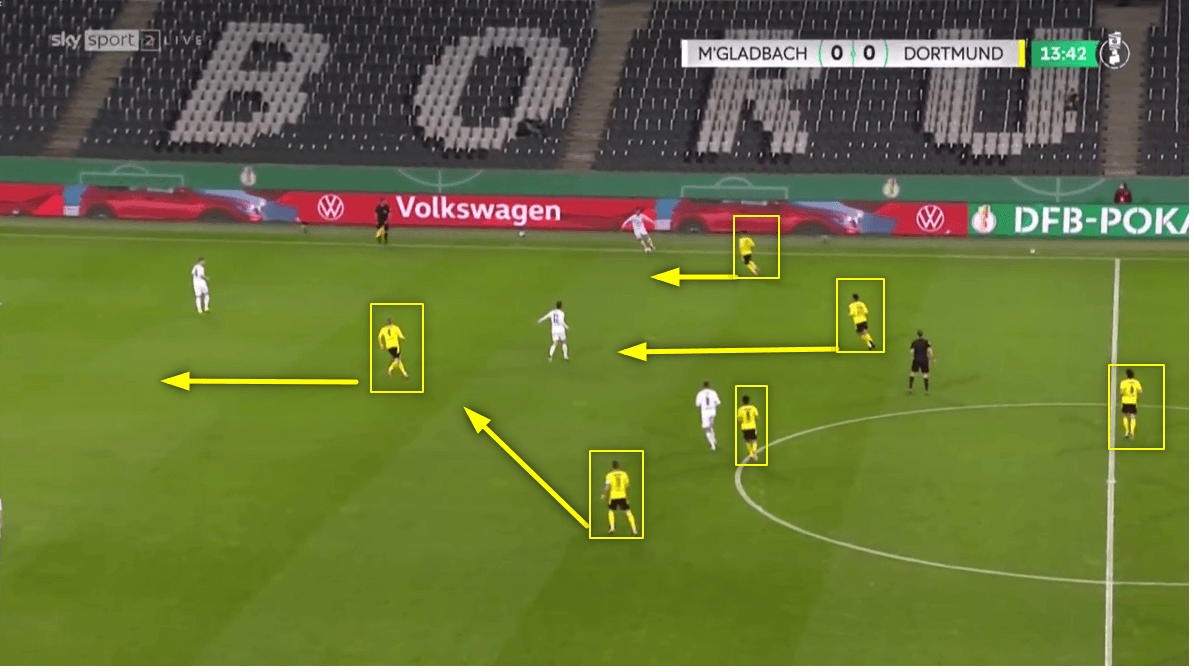
From that point, Bellingham will push up on Borussia Monchengladbach’s holding midfielder and Marco Reus who is playing down the left-hand side will run further inside which successfully cuts the pitch in half and compress all space available for Gladbach to be able to play through.
As the pitch becomes smaller and when all viable passing lanes are blocked, Dortmund will then look to win the ball back by counter-pressing.
Attacking Phase
During possession Terzic wants his team to make the pitch as big as possible when they are playing through the defensive and middle thirds of the pitch
This starts right from the goalkeeper during the build-up phase. The Goalkeeper during this period was Roman Bürki who featured heavily in Dortmund’s build-up. The goalkeeper would become involved in the passage of play if Dortmund were unable to beat the opposition’s press at the first attempt. Instead of a defensive midfielder dropping between the centre backs, Burki or whomever was playing in goal would push up onto the edge of the area so the centre backs can split wider.
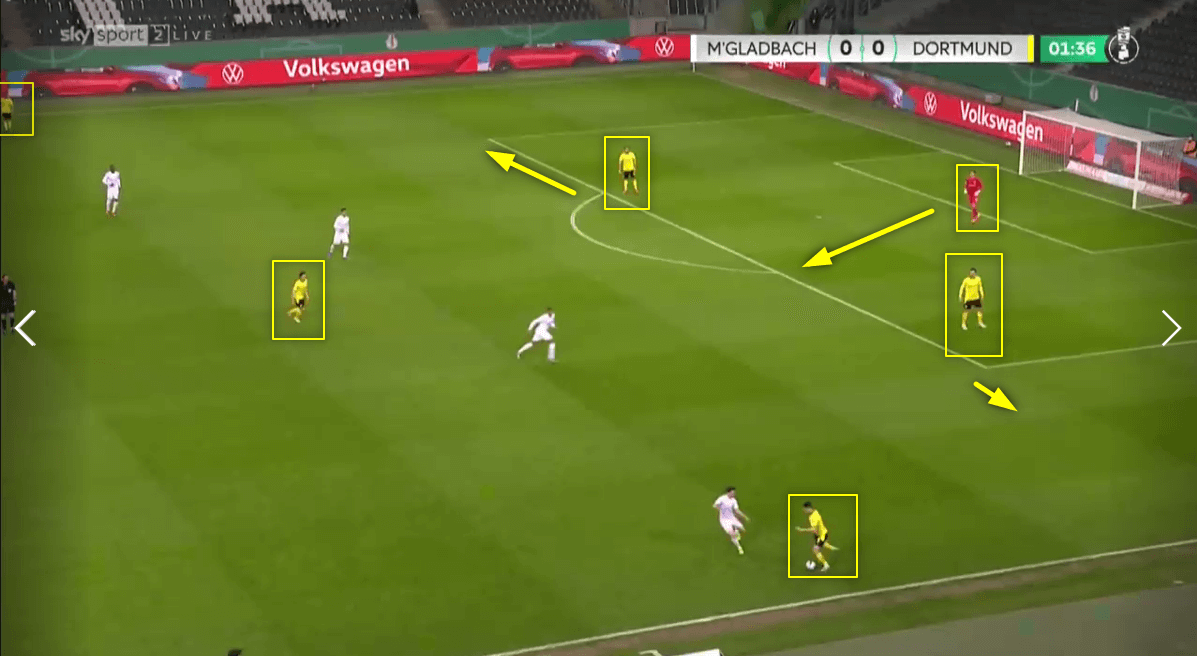
This would often draw the opposition’s press higher up and more towards the goal which means more space becomes available. Dortmund’s preferred passage of play when moving from a defensive third to the middle third is through the fullbacks. The centre-backs are used, but primarily, they operate as a decoy and provide support for the full-backs.
In the image below you can see how the Roman Burki has pushed up into the defensive line.
Throughout Edin Terzic’s time in charge, Dortmund provided different patterns in their build-up play. If their build-up through the full-backs was becoming nullified by the opposite team, their possession shape in their half of the pitch would become a 4-2-2-2. As this image shows
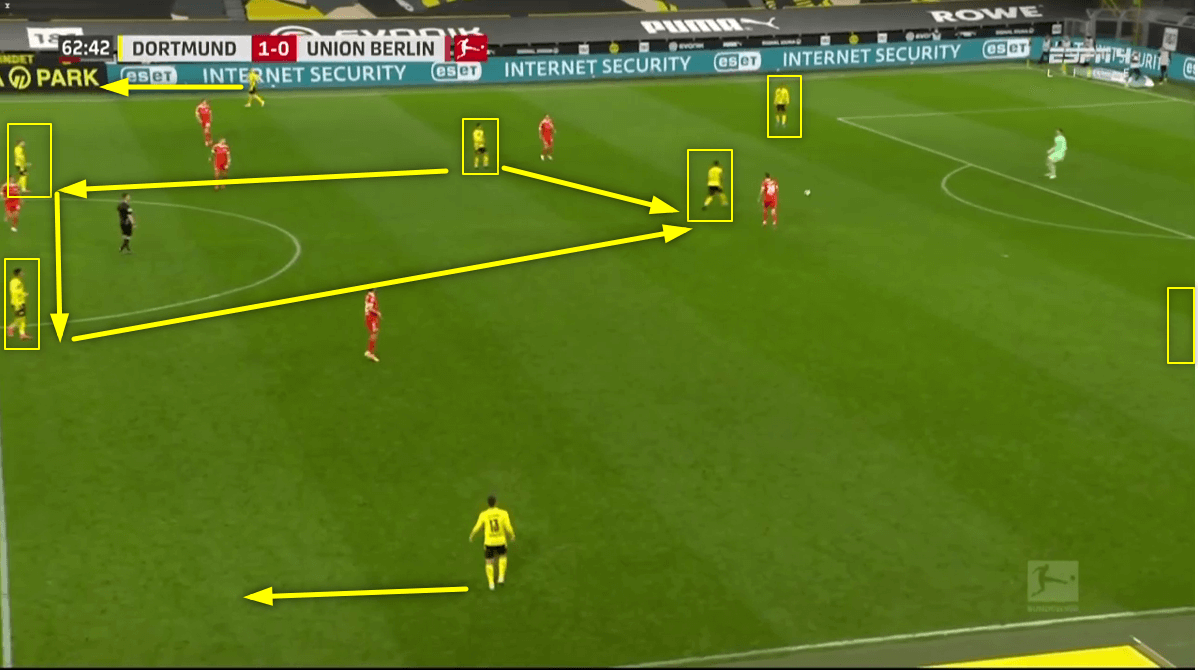
Two midfielders drop deep to form a double pivot and then the wide players come further inside to form a box shape midfield. What this does is stop the opposition from forming a defensive block across each zone of Dortmund’s half. Because if they did, it would allow Terzic’s team to form an overload in the centre of the pitch and provide them with a better opportunity to progress through the middle.
Look at how much more space the fullbacks have against Union Berlin compared to against Borussia Monchengladbach in the previous image.
Once Dortmund enters the attacking third or attempts to progress to the attacking from the middle third, Terzic tactics become less structured.
Their attacking shape becomes more fluid and offers more rotations and positional movements between the players. You can see below how the attacking shape transitions into a 3-2-5/3-4-2-1 shape. Nico Schulz has tucked inside to make a back three as Thomas Meunier pushes higher to provide width down the right. As the ball is played through to Haaland, Schulz pushes up further up to support the wide area on the left-hand side. The attacking approach then starts to resemble a 4-2-4.
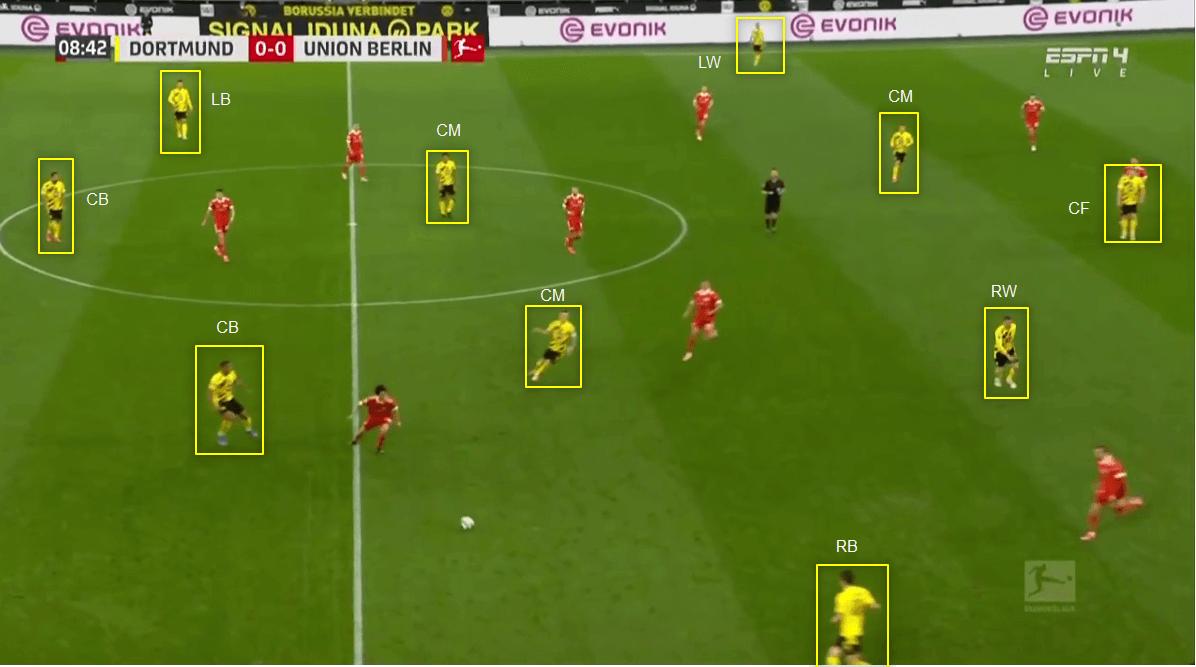
Part of Edin Terzic’s tactics is for Dortmund to attack the opposition with different patterns. Look at how the attacking approach differs in the same game Union Berlin, and how the position of the players has changed. This time both full-backs are pushing higher and one of the midfielders has dropped deeper to form the three-man defensive line. They are now attacking in a 3-1-3-3 shape. As the fullbacks move higher, they outnumber Union’s back four as Dortmund attacking line becomes a front five.
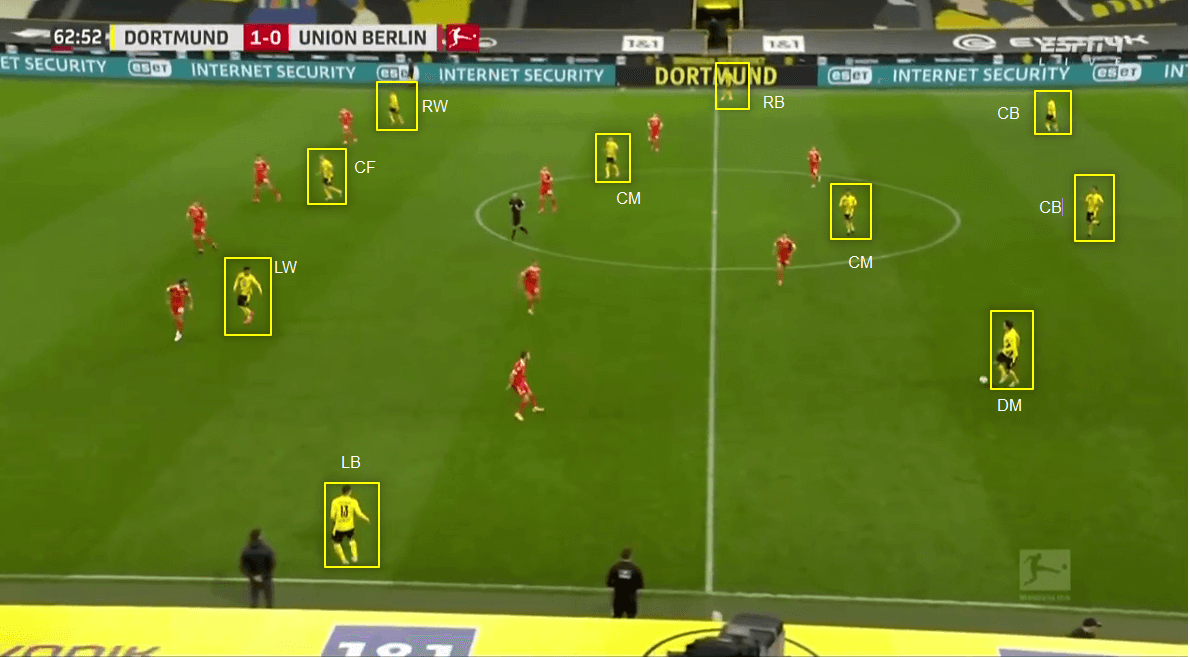
What is he taking over this time around?
The last time Edin Terzic took over Die Schwarzgelben was mid-season, and they had just been defeated 5-1 at home to newly-promoted Stuttgart. Although no one had expected the defeat to Stuttgart, it felt like it was only a matter of time for Lucian Favre.
This time Terzic is taking over from Marco Rose, the man who Dortmund appointed after Terzic’s period as interim manager.
Rose’s sacking came as a shock as it was expected that he would be given at least one more season to reshape the squad after Erling Haaland’s expected departure. Even though the team finished second in the Bundesliga, the stats show Dortmund were far from impressive under the former Red Bull Salzburg manager.
The data below shows their goals against versus their expected goals against for the league campaign. Dortmund ranked tenth for the number of goals conceded, which for a team whose aim is to challenge Bayern Munich for the title. is unacceptable.
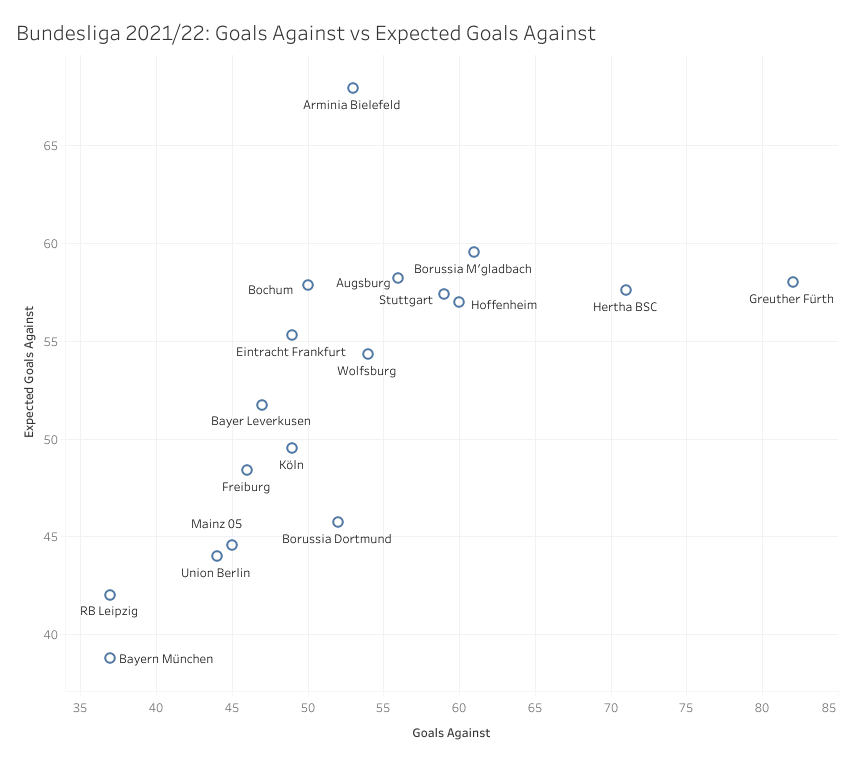
Under Rose, they were far too reliant on their attacking play and individual quality. They finished second to Bayern Munich for the average amount of possession with 58.4%. Marco Rose’s philosophy is to play quick vertical football with an emphasis on playing high up the pitch.
Dortmund finished seventh for the number of progressive passes attempted per 90 minutes and the for the number of shots they had per 90 minutes. The two data graphs show several teams all held less possession but were more progressive and decisive with their play.
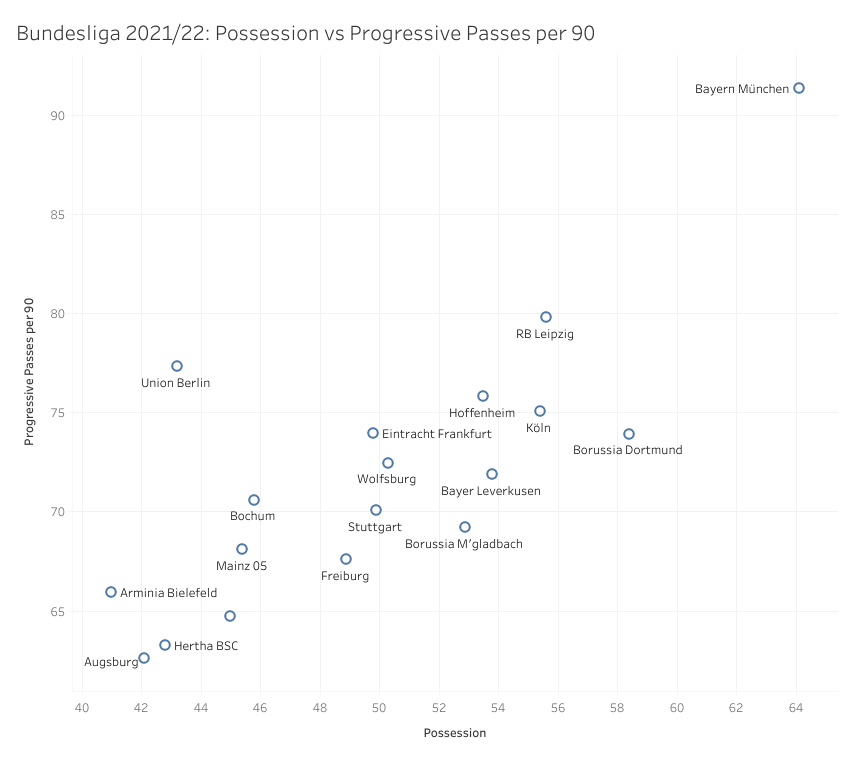
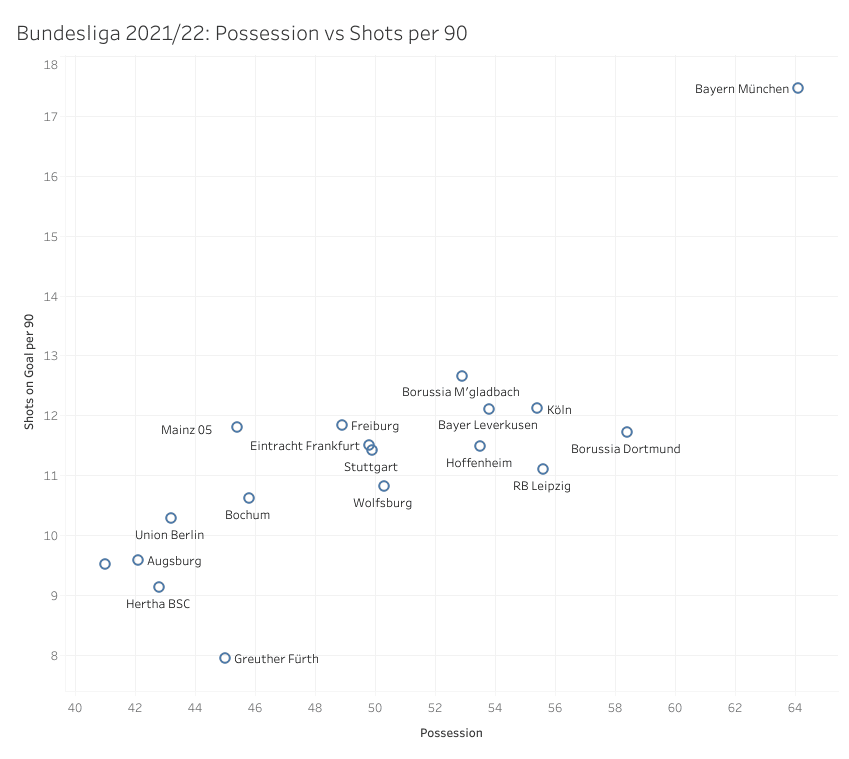
It appeared that under Rose, Dortmund was far too focused and one-dimensional with their attacking threat. Edin Terzic’s tactical approach differs from that of Rose. His Dortmund team were far more defensively organised and though he still wants Dortmund to play with verticality and quick transitions in possession, Dortmund will be more tactically diverse under the young Croatian manager.
Conclusion
Dortmund ended Terzic’s first spell in charge in fantastic form. They won their last nine domestic games including a 4-1 win over RB Leipzig in the DFB-Pokal final.
Everything seemed to have clicked and although the club had already committed and announced Marco Rose would be taking charge the following season, sections of the German media and Dortmund fanbase feel Terzic was better suited for the role at that period.
Moving forward to this season, there is a sense of togetherness following his appointment and even though he will not be able to call on Erling Haaland and Jadon Sancho this time around, the club has moved quickly and efficiently in this transfer window and have already signed eight players.
In this analysis, we have shown the key principles that Edin Terzic implemented throughout his time as interim manager, as well as the attacking and defensive issues that Terzic will have to rectify to take the club forward,





Comments